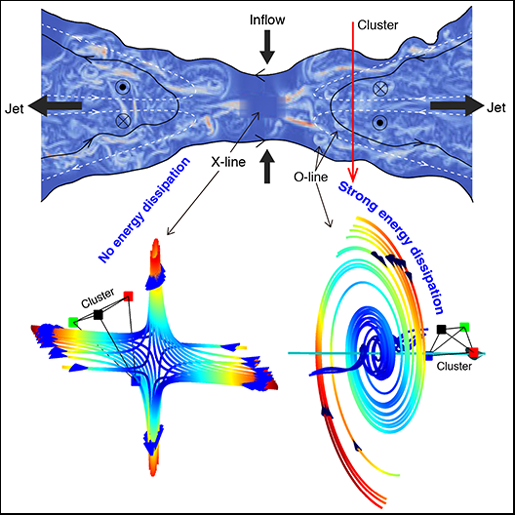Source: Geophysical Research Letters
Magnetic reconnection is one of the most important—and least understood—processes in all of space physics. It happens at the boundaries of Earth’s magnetic field, where it meets the Sun’s, causing magnetic field lines to break and realign in an explosive manner that can generate hazardous radiation, especially during solar storms. Now a new study from Fu et al. adds weight to suggestions that scientists have been looking for this energy in the wrong type of reconnection.
For decades, the classic introductory textbook picture of magnetic reconnection has depicted two parallel lines that pull themselves together into an X shape, as if pinched together, until they finally touch at the center of the X line. Then, the field lines snap and realign. Like a rebounding rubber band, they fling plasma out from the center of the X, generating currents than can surge down into the Earth’s magnetic field. During high solar activity, this process generates the dangerous radiation that threatens power grids, satellite communications, and the health of astronauts.

At least, that is the conventional wisdom. But that’s not what the authors’ analysis shows. Instead, the intense blasts of energy may come from a different kind of magnetic reconnection, one not as often shown in textbooks: so-called O lines, where the approaching field lines spiral and swirl together, as if caught in a whirlpool.
The team analyzed data from the European Space Agency’s Cluster satellites, a quartet of spacecraft launched in 2000 that fly in formation—sometimes less than 10 kilometers apart—which allows them to make detailed measurements from within magnetic reconnection events. In particular, the authors examined a pass through a magnetic storm on 9 October 2003, high over Earth’s nightside.
During their pass through this storm, the craft flew within a few hundred kilometers of several potential sites of reconnection. The team used computer models to recreate the topology of the field lines, finding that two of them were X lines and the rest were O lines. But instead of seeing the highest current levels at X lines as expected, the team found most of the greatest current spikes to be near O lines. At the X lines, the current was almost nonexistent.
The team writes that their results clearly show that O lines, not X lines, are responsible for energy dissipation in reconnection, a result that is likely to spark a great deal of discussion. (Geophysical Research Letters, https://doi.org/10.1002/2016GL071787, 2017)
—Mark Zastrow, Freelance Writer
Citation:
Zastrow, M. (2017), For magnetic reconnection energy, O—not X—might mark the spot, Eos, 98, https://doi.org/10.1029/2017EO070891. Published on 10 April 2017.
Text © 2017. The authors. CC BY-NC-ND 3.0
Except where otherwise noted, images are subject to copyright. Any reuse without express permission from the copyright owner is prohibited.

